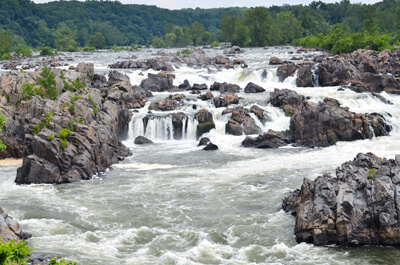George Washington Memorial Parkway
The Potomac River through History
| Mileage | 27 miles (44 km) |
|---|---|
| DurationThe duration is an estimate of a one-way drive and does not include any stops or side-trips. | 47 minutes |
| SeasonsThe seasons listed are the best seasons for this scenic drive. If Winter is not mentioned, the road may be closed during the winter. | All Seasons |
| Roadways | George Washington Memorial Parkway |
| ServicesThe cities or towns listed have either Food or Services such as gas, pharmacies, etc. | Tantallon Hills, MD▼, Alexandria, VA▼, Annandale, VA▼, Lorton, VA▼, Springfield, VA▼, Clinton, MD▼, Washington, DC▼, Bladensburg, MD▼, more...Hyattsville, MD▼, Vienna, VA▼, Bolton, MD▼, Oaklawn, MD▼, Tantallon, MD▼, Dalecrest, VA▼, Delta, VA▼, Colonial Village, VA▼, Dover, VA▼, Chesterbrook, VA▼, Cheverly, MD▼, and Landover, MD▼ |
| Rating | 3.7 average from 35 votes |
| My DrivesTrack your favorite scenic drives by selecting those which you want to take and those that you have taken. Using your free account, simply sign in and select My Drives. | |
| Share |
Our free Road Trip Planner will reverse the route and include the places of interests. Click the “Add to Road Trip” above to start planning your next road trip.
Send this link to your phone. Standard text messaging rates apply.
() -Get directions from your start address to the beginning of and including this scenic drive. Choose either an alternate ending or same as start.
Have more destinations? Use our free Road Trip Planner to completely plan your adventure. Click the “Add to Road Trip” above to start planning your next road trip.

A journey through history, this scenic drive follows the Potomac River from President George Washington’s Mount Vernon home, past the nation’s Capital to the Great Falls of the Potomac. This is relatively short drive but hours can be spent walking in the footsteps of history.

The scenic drive begins in Mount Vernon. Visit George Washington’s Mount Vernon Estate and Gardens (A1) which stands proudly on the banks of the Potomac River. Learn about Washington’s life as the first American President, his military career, his passion for science-based agriculture and personal life with a tour his family home, original furnishings, and meticulous gardens. The Donald W. Reynolds Museum and Education Center features 25 theaters and galleries that depict Washington’s life through artifacts, exhibits and video presentations. There is much to see and do here, including visiting the Ford Orientation Center, Pioneer Farm Site and Heritage Animals which house breeds raised here more than 200 years ago including the Ossabow Island Hog and Dominique Chickens. Pay your respects to this fascinating man at Washington’s Tomb.
Following virtually the same path as the George Washington Memorial Parkway is the Mount Vernon Trail, a paved trail that runs for 18.5 miles along the Potomac shoreline. Bike, jog or walk along the trail, stopping at your leisure to take in the sights and enjoy the quiet water views.
The first section of this Parkway was completed in 1932 to commemorate the bicentennial of George Washington’s birth and was designed to preserve the environment through which it travels. As the maple and oak forests open upon the Potomac River again, you arrive at Riverside Park (H1). Frequented by osprey and other waterfowl, this park highlights the importance of preserving ecological sites near urban cities. Enjoy the peaceful retreat with a stroll through riparian woodlands.
Fort Hunt Park (H2) was used by the military for a number of projects, including guarding the Potomac River between 1898 and 1918 and as a top secret World War II intelligent camp. Across the Potomac lies Fort Washington, an 1824 coastal fortification. Of interest for both the history and recreation opportunities, take advantage of the ranger programs and special events.
As you continue on the Parkway, the road bends as you arrive at River Farm (A2), now the headquarters for the American Horticultural Society. The farm has gorgeous gardens and is a worthwhile stop.
The simply-designed Jones Point Lighthouse (A13) is one of the few remaining river lighthouses. Built in the mid 1850’s, it guided ships traveling through the third busiest port on the Chesapeake. The surrounding Park is a pleasant spot for fishing and picnics.
The Dyke Marsh Wildlife Preserve (A3) consists of 485 acres of tidal marsh, floodplain and swamp forest which creates an ideal habitat for beaver, muskrat leopard frogs, painted turtles and more. Almost 300 species of birds can be seen here, making this one of the top birdwatching spots in D.C.
Continuing north, you arrive in Alexandria. Founded in 1749 as a port town, it is listed on the National Register of Historic Places. Alexandria is also George Washington’s hometown and hosts some of the most important landmarks in the United States such as the George Washington Masonic National Memorial, Robert E. Lee’s boyhood home, and Gatsby’s Tavern. Now an eclectic mix of history and urban sophistication, it is a major tourist destination. Hip art galleries, chic restaurants, unique shops and historic buildings line Old Town. For a lively and colorful experience, don’t miss the Alexandria Farmers’ Markets on Saturdays, thought to be the oldest continually operating market in the nation. The Ramsay House Visitor Center (I1) is a great place to pick up maps and get more information.
As you leave Alexandria, Daingerfield Island (H3) is on the right. Though more of a peninsula than an island, the park is the site of the first permanent settlement in Alexandria and is now an excellent location for birding, picnicking and watching the passing sailboats at the nearby marina. Being close to the Ronald Reagan National Airport, it’s also great for watching planes take off. The nearby Roaches Run Waterfowl Sanctuary (A14) is another popular spot for observing waterfowl, eagles, osprey and Eastern Painted Turtles.
Back on the parkway, the Washington DC skyline is visible in the distance. Visit the beautiful Lady Bird Johnson Memorial Park and Lyndon Baines Memorial Grove (H5). Spring will dazzle with more than 1 million bright yellow daffodils and thousands of tulips in bloom. The Navy and Marine Memorial can also be found here.
The Arlington Memorial Bridge symbolically links north and south, connecting the Lincoln Memorial, Arlington House, and the Robert E. Lee Memorial. If you haven’t already explored D.C., this is the perfect time to detour from the Parkway. The Lincoln Memorial (A8) is inspiring, and the emotional impact of this memorial honoring Abraham Lincoln, the 16th president of the United States is powerful. The building design is based on a Greek temple with 36 doric columns, each representing a state of the Union at the time of Lincoln’s death. Enjoy great views of the Capital from its lofty heights. Continue on to the Washington Monument (A9), the most prominent structure in D.C. The obelisk stands 555-feet tall and was built in 1884. Vising the monument is free but requires a timed ticket which can be picked up on a first come, first served basis. It is highly recommended that you reserve a ticket online at the National Park Service ticket website. There is a service charge but well-worth it, as tickets are often reserved months in advance. The White House was designed by James Hoban and originally built between 1792-1800. It was rebuilt after being set ablaze by the British during the War of 1812. The White House is spacious, boasting 132 rooms and 35 bathrooms. Most people take photos from outside the gate. If you would like to tour inside, you must submit a request to your Member of Congress, a minimum of 21 days in advance, and a maximum of 6 months, which we highly recommend as there are a limited number of places available. Tours are free. The Smithsonian (M1) consists of 19 museums and galleries, a National Zoological Park and nine research facilities. Entrance is free and each offers an incredible experience. The Natural History Museum, Air and Space Museum, Hirshhorn Museum and Sculpture Garden and American History Museum are but a few to discover. If you are here in spring, do not miss the National Cherry Blossom Festival typically held mid-March to mid-April. Check their website for peak bloom schedule. Along with the delightful sight and scent of cherry blossoms, enjoy events such as musical performances, a parade, kite-flying and fireworks.
Returning to the George Washington Memorial Parkway, explore the Arlington National Cemetery (A4) where more than 300,000 American Soldiers are buried, spanning the Civil War to present day. Arlington House (A5), the home of Robert E. Lee and his family for 30 years, is now preserved as a memorial and open for visits. Nearby, the Women in Military Service for America Memorial (A6) was dedicated in 1997 to honor all of the women which have helped and fought in the US wars. The Marine Corps War Memorial (A7) honors all of the US Marines who served the United States since 1776.
As you continue north, you arrive at Theodore Roosevelt Island (A10) which honors the 26th President of the United States. One of the greatest contributions of President Theodore Roosevelt was the creation of the National Parks Program that began with Yellowstone National Park. Many of his quotations are part of the memorial and none more fitting today as it was then “The nation behaves well if it treats the natural resources as assets which it must turn over to the next generation increased and not impaired in value.” Here you can walk a section of the Potomac Heritage National Scenic Trail, a non-continuous 830-mile network of trail, and along with serene beauty of nature, be ready for muddy patches and hills.
The scenic drive continues, passing parks and splendid views of the Potomac. Fort Marcy (A11) is one of the 138 forts built around Washington D.C. during the Civil War. Today the fort is preserved as a peaceful retreat to remember the struggles and conflict of those who fought to protect us.
Turkey Run Park (A12) is an excellent location for a picnic, birding, or a stroll among the wildflowers and Potomac River. Only 7 miles from downtown D.C. you will feel transported far from city life. Traverse some of the 700 acres of forested land via the Turkey Run Park Trail or on a section of the Potomac Heritage National Scenic Trail that passes through here. A diverse habitat for plants and animals, there are 11 species of snakes including the venomous Northern Copperhead, Red-bellied Turtle, Broadhead Skink, beaver, white-tailed deer and more.
This Parkway officially comes to an end as you arrive at the I-495, but you should continue to Great Falls Park (H4) and Mather Gorge. A National Park, there is an entrance fee covered by the America the Beautiful Interagency Pass. Flowing over the jagged rocks, the Potomac River is a sight to behold. View the falls from three overlooks, two of which are handicap accessible. Stop at the Visitor Center for exhibits on the history of the area, guided programs and hiking maps. The park is a haven for recreation such as horseback riding, cycling, fishing, whitewater boating and rock climbing and climbers must register at the visitor center beforehand.





